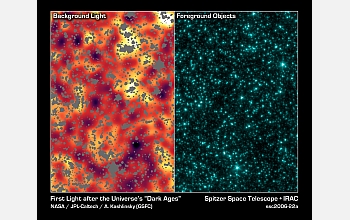Multimedia Gallery
Before data processing, stars and galaxies drown out the infrared background radiation.
The right panel is an infrared image from NASA's Spitzer Space Telescope of stars and galaxies in the Ursa Major constellation. The image covers a region of space so large that light would take up to 100 million years to travel across it. The left panel is the same image after stars, galaxies and other sources were masked out. The remaining background light is from a period of time when the universe was less than 1 billion years old, and most likely originated from the universe's first groups of objects -- either huge stars or voracious black holes. Darker shades in the image on the left correspond to dimmer parts of the background glow, while yellow and white show the brightest light.
Credit: NASA/JPL-Caltech/GSFC
Images credited to the National Science Foundation, a federal agency, are in the public domain. The images were created by employees of the United States Government as part of their official duties or prepared by contractors as "works for hire" for NSF. You may freely use NSF-credited images and, at your discretion, credit NSF with a "Courtesy: National Science Foundation" notation.
Additional information about general usage can be found in Conditions.
Also Available:
Download the high-resolution JPG version of the image. (3.8 MB)
Use your mouse to right-click (Mac users may need to Ctrl-click) the link above and choose the option that will save the file or target to your computer.
Related story: Universe's Oldest Objects Emerge from the Background



